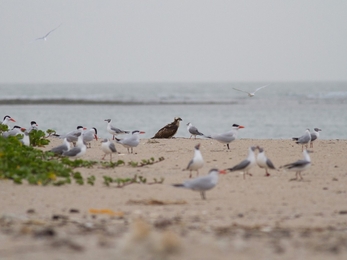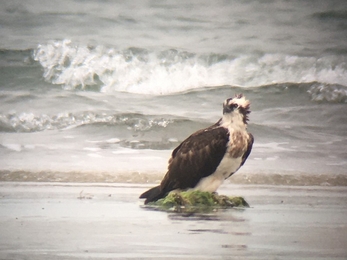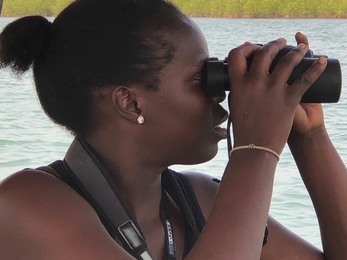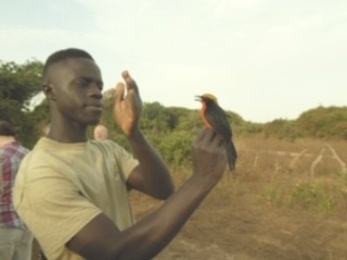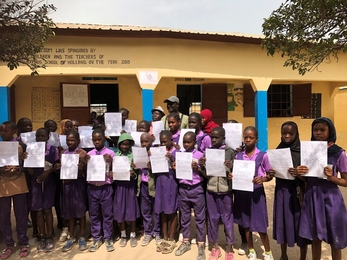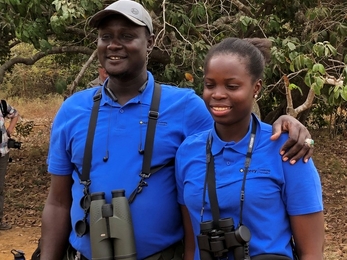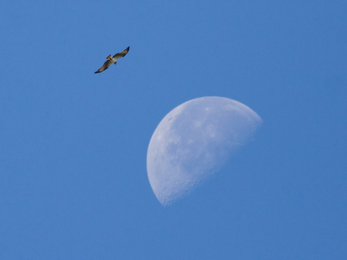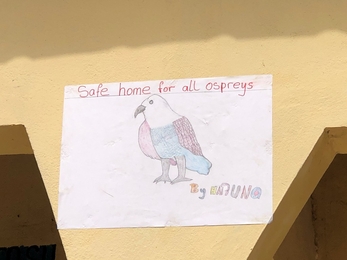Imagine a January walk along a deserted beach on the west coast of Africa. Miles and miles of golden sand, coming up through your toes as you walk barefoot along the water’s edge. Gentle waves rolling in from the deep blue Atlantic Ocean, leaving a salty tang on the warm breeze that you can taste on your lips. Seabirds and shore birds everywhere, distant brightly painted fishing boats preparing to cast their nets. Otherwise, nothing. Just you. We need a closer look at this amazing place.
Osprey Watching in Africa
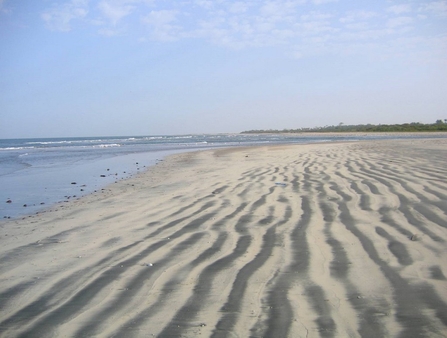
This is in fact a beach in the small West African country called The Gambia. You can find beaches just like this up and down this coastline, from Senegal to the north as far down as Sierra Leone to the south. The beaches are not always quiet, like this one is today. They are often crowded with local people, waiting to greet the fishermen as they return with their catches and take their fish off to markets. But they are not here today. The boats will stay out all night, and return tomorrow morning. Let’s walk on and enjoy the peace and quiet.
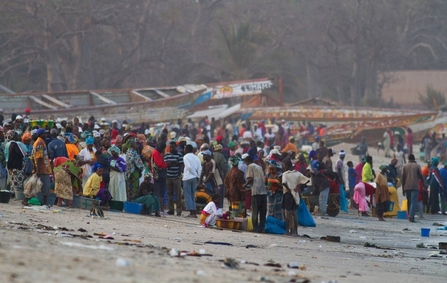
A closer look at the birds tells us that many of them are species which live here all the year round. There are Pink-backed Pelicans, floating serenely on the water like stately Spanish galleons, or flying over in V-shaped flocks. Grey-headed Gulls, very like our Black-headed Gulls but with one obvious difference, are common here. Various types of heron and egret fly over us, some white and some black. Hooded Vultures sit on the beach in groups, like witches huddling around a cooking pot.
But wait a minute. There are other birds here too, which are visitors, like us. Some are birds of the shore line, running about on the beach and probing in the sand for food. I can see Bar-tailed Godwits, Whimbrel and Sanderling. Others are birds of the air – swallows and martins - catching flying insects just as they did last year over places like Rutland Water. Their other home is thousands of miles to the north, in Europe and even above the Arctic Circle, and just a few months ago that’s where they were, laying their eggs and rearing their young. Now they’re here, escaping the freezing northern weather, and spending time building up their strength again for the long journey back in the European spring.
Out to sea, there is a sandbank. We can see some large brown and creamy white birds sitting on it, but what could they be? Time to get the telescope out and have a proper look….
Maybe you have guessed already what they are. Yes, that’s right: OSPREYS!
Ospreys come to places like this from their breeding grounds in Europe at the end of September and early October. Some have come here for the first time this year, while others have been coming for anything up to twenty years – always to the same part of the coast, often to the same beaches, lagoons, marshes and lakes. There is no shortage of fish in the sea, and these Ospreys we can see now have all caught fish earlier this morning and are now resting and digesting their meal. If they had stayed in the cold regions of northern Europe, they would not be able to survive. Here, in the African sunshine, they can live a life of leisure, without having to worry about building a nest and bringing up their young. All that can wait until next spring, when most of them (apart from the youngest) will once more return to their summer homes, where people like you and me will be waiting for them.
Two young Gambian people are out on the beach today too. They have moved away from the sea and are using their binoculars and telescope to look at the birds in a large area covered in shrubs, mangroves and small trees. As I get closer I recognise them – it’s Dembo and Naffie! We know them well. We have met before. They are good friends of the Ospreys, and all the other birds too.
Dembo and Naffie are both from the nearby Kartong Bird Observatory, where they are training in Bird Research. They spend a lot of time, with other people, identifying and ringing hundreds of birds of different types every year, and keeping careful records of every single one. Today they are watching a group of eight very special birds and taking wonderful photographs of them. These birds are migrants too – visitors from further south and east in Africa and soon to depart. We watch these Northern Carmine Bee-eaters for a long time together.
Dembo and Naffie have a lot to tell us. They speak English well, because English is the language used in all the Gambian schools, and everyone speaks and understands it. Today they want to tell us about the Ospreys, which have been living here since arriving at the end of their long migration from Europe.
Dembo takes up the story : ‘ Every year, from the end of September onwards, we wait for the Ospreys to come back to The Gambia. We have some that stay with us all the year round – these are the young ones, which are not old enough yet to fly back to their summer homes. We wait on beaches, near lakes, quarries, marshes and lagoons – anywhere where we know the Ospreys like to catch fish or rest on wooden stumps or on tree branches. And every day from about October onwards, there will be more Ospreys for us to watch’.
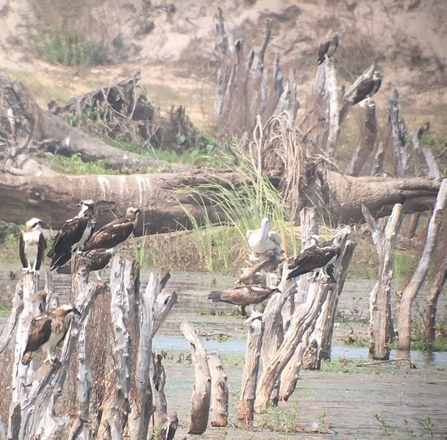
Naffie carries on. ‘We look at every Osprey very carefully,’ she says, ‘to see if it has a ring on its leg. Many do not, because they come from countries where they cannot ring all the Ospreys. But it is very exciting when we find one with a coloured ring on its leg, and then we do all we can to read the number on the ring and report it back to the country it came from. We have seen Ospreys from many different countries, including Germany, Spain, Finland and the UK. The same ones sometimes come year after year, and that makes us happy. Some stay only a short while and then move further down to other countries like Guinea and Guinea-Bissau.’
‘What’s the most exciting day you’ve had when watching the Ospreys?’, I ask.
‘That’s easy’, Dembo replies, ‘and it happened just a few days ago. We were out here on Kartong Beach when I spotted an Osprey in the distance. Through the telescope I could see it had a blue ring on its right leg, and after a while I could read the numbers, 056. I had already learned that a blue ring on the right leg means that an Osprey comes from England or Wales. We have many friends there – especially at Rutland Water – so I couldn’t wait to send an e-mail to tell them. And that is not the best part! I got a message straight back which told me that 056 is a very special Osprey indeed! He is a young male, only a few months old, and he is the 150th Osprey chick to be hatched there since the Rutland Osprey Project began many years ago! Everyone here is so happy that their special Osprey has made his first migration and arrived here in The Gambia safely. He has been seen several times since that day.’
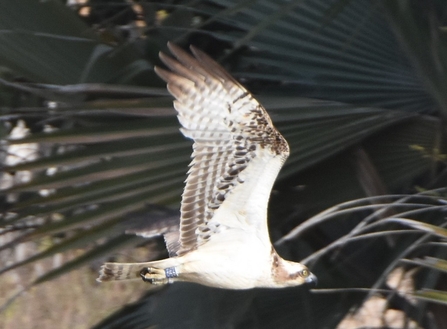
As we make our way back to the Kartong Centre with Dembo and Naffie, all this sinks in for me. Here I am, almost four thousand kilometres from home, talking to two young African Osprey experts, just as I do at the Lyndon Reserve with our Osprey Ambassadors. The Osprey is an amazing link, enabling us to make new friends at either end of the epic migration, and it is people like these two who are making that link stronger and more important every day.
Naffie tells me that only a few days ago she went back to her old school in Kartong, to tell the children there about the Ospreys and give them copies of our Ozzie story books. And, together with our established contact Jungkung Jadama, she has been to several schools in the area, spreading the Osprey message and taking the children out to see these fantastic birds for themselves
Dembo and Naffie are being supported both here in Africa, and from the UK by the Osprey Leadership Foundation, which exists to encourage people just like them to become conservation leaders of the future. Their knowledge, enthusiasm and involvement in so many important areas of concern give us all hope that the natural world will still have its champions in years and decades to come.
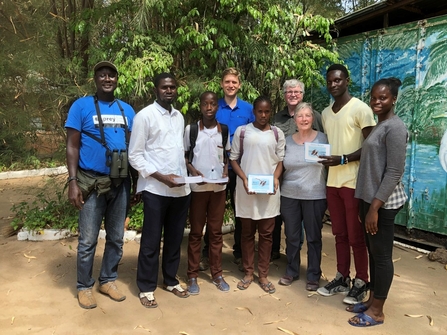
(c) Paul Stammers
Back on the beach and on my own now, the tide has come in and the sandbank has been covered. The Ospreys will have moved inland, or perhaps gone out to sea for another fish. I recall other days, other beaches, other countries, where we have watched Ospreys starting their migrations, whether north to south, or south to north:
‘Will he come back?’
‘Yes, he will, but not for a long time. You see, he is flying back to his other home, where other children, just like you, are waiting for him.’


